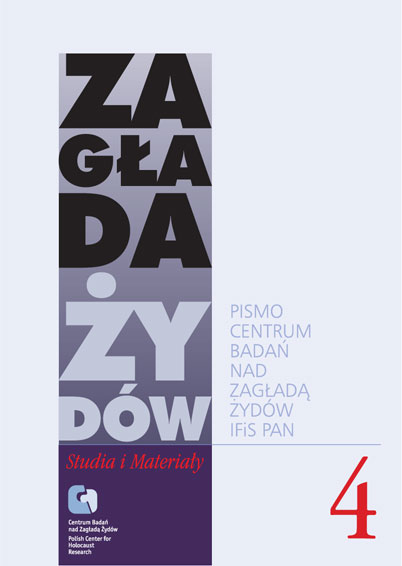An Image Regained
Zagłada Żydów. Studia i Materiały, No. 4 (2008), Pages: 383-402
Submission Date: 2020-12-06Publication Date: 2012-12-02
 https://doi.org/10.32927/zzsim.696
https://doi.org/10.32927/zzsim.696
Abstract
The identification photographs of Auschwitz-Birkenau prisoners are a Holocaust icon. Photography, particularly identification photography, seems especially ambiguous in the context of the Holocaust, and the manner in which it was used and then conceptualized seems especially problematic. The remnants of the postwar photographic practice of former concentration camp prisoners are all the more puzzling: some of them had their photographs taken in concentration camp stripes in professional photo studios. Some dozen photos taken during 1945–1947 show survivors who decided to record their images as ex-prisoners. By doing so they referred to the prewar portrait photography tradition and repeated the gesture of putting on concentration camp outfits and (perhaps) the experience of being photographed in the camp. Compared with the practice of taking identification photographs, the portraits turn out to be a material whose interpretation problematizes the issue of radically different ways of using photography as an institutional tool of oppression on the one hand and as a tool of individual confrontation with the traumatic experience on the other. The comparison of identification and portrait photographs is an occasion to reflect on the ways in which photography was used in the context of the Holocaust and at the same time on the condition of photography as a medium
License
Copyright (c) 2012 Author&"Holocaust Studies and Materials"

This work is licensed under a Creative Commons Attribution 4.0 International License.
https://creativecommons.org/licenses/by/4.0
The journal is published under the Diamond Open Access Standard, CC-BY-4.0 Deed - Attribution 4.0 International - Creative Commons
Similar Articles
- Piotr Trojański, “We need to send him one, because he is a ‘goldsmith’ or ‘Canada man’.” Case of an Oświęcim Camp Security guard , Zagłada Żydów. Studia i Materiały: No. 11 (2015)
- Caroline Sturdy Colls, Gone but not forgotten: Archaeological Approaches to the Site of the Former Treblinka Extermination Camp in Poland , Zagłada Żydów. Studia i Materiały: No. 8 (2012)
- Marta Zawodna, On the Clearing of the Post-Camp World. Ways of Handling the Human Remains at the Former KL Auschwitz-Birkenau Camp from the Final Evacuation to the , Zagłada Żydów. Studia i Materiały: No. 8 (2012)
- Heléna Huhák, András Szécsényi, Cavalcade of Interpretations: The Kasztner train Through the Self-narratives of the Fugitives , Zagłada Żydów. Studia i Materiały: No. 18 (2022)
- Agnieszka Haska, Auschwitz from Auschwitz or how to write a bestseller , Zagłada Żydów. Studia i Materiały: No. 16 (2020)
- Monika Adamczyk-Garbowska, Three Visits to Auschwitz , Zagłada Żydów. Studia i Materiały: No. 14 (2018)
- Michał Kowalski, Treblinka Penal Labor Camp I as Presented in Jewish Testimonies , Zagłada Żydów. Studia i Materiały: No. 18 (2022)
- Ewa Cuber-Strutyńska, Witold Pilecki. Confronting the legend of the “volunteer to Auschwitz” , Zagłada Żydów. Studia i Materiały: No. Holocaust Studies and Materials (2017)
- Tomasz Łysak, Yolocaust: Platform Capitalism and Digital Holocaust Commemoration Practices , Zagłada Żydów. Studia i Materiały: No. 17 (2021)
- Tadeusz Bartoś, Invariable Right to Great Death. Otto Kulka, Landscapes of the Metropolis of Death. Commentary , Zagłada Żydów. Studia i Materiały: No. 10 (2014)
1 2 3 4 5 6 7 8 9 10 11 12 13 14 15 16 17 > >>
You may also start an advanced similarity search for this article.
 English
English
 Język Polski
Język Polski




